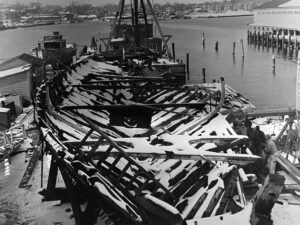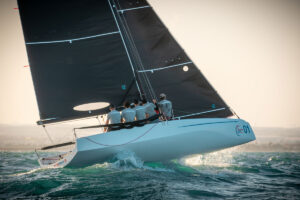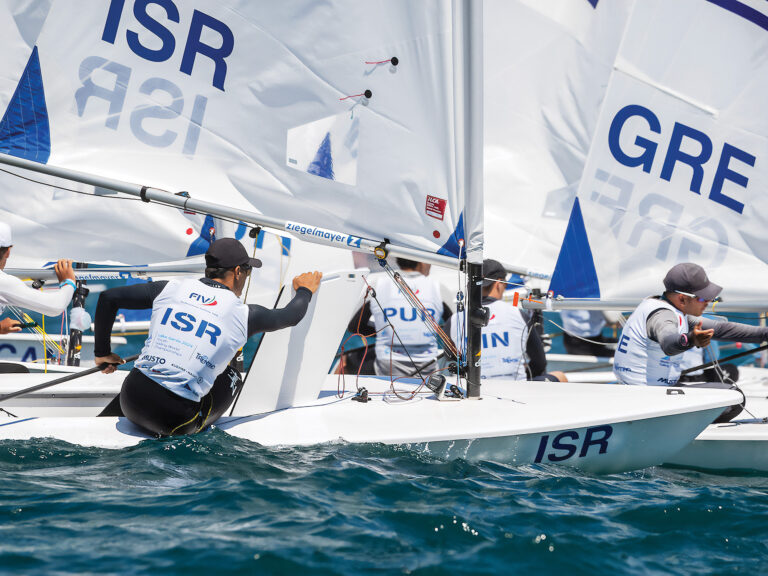Are you tired of losing races and having lousy cruises with your not-so-dual-purpose boat? Worried about being the first (and last) buyer of a promising class that doesnt quite pan out? Take the fear out of commitment and look at the J/109, a 35-footer that joins the short list of accomplished production-built racer/cruisers.
|
|
| |
|
|
| |
| Courtesy Rolex Middle Sea Race|
| |
|
|
| |
| The J/109 Market Wizard won its class, division, and overall honors at the Rolex Middle Sea Race, a 600-mile distance race in the Med.* * *|
| |
|
|
|
If you havent actually seen the J/109 yet, youre probably wondering how it stacks up with a stablemate thats nearly the same length, the J/105. The two boats appeal to different people, says designer Alan Johnstone. The 109 is 12 years newer, faster, and is more comfortable for cruising. The 105 is for people who live close to where they keep their boat. Compared to the 105, the 109 has overlapping headsails and more interior volume, the result of the larger boats initial target market. This boat was originally designed for the European market, says Jeff Johnstone of J Boats. The demand there is for a boat that sails well, can comfortably handle a crew living aboard for weekend regattas, and does reasonably well under IRC and IMS. Reasonably well might be an understatement; the 109 has scored big in Europe since its introduction in 1999, winning the Rolex Middle Sea Race and Cowes Week.
The J/109 is a tad over 35 feet long, and weighs 10,900 pounds empty. It has a purposeful, racy style, with an almost vertical bow above a waterline-kissing knuckle, and an open stern. The deckhouse is low and long and helps give the boat an overall pleasing look. A carbon sprit housed in a self-draining tube peeks out of the hull just below deckline on the starboard side. The aluminum rig is tall without being freakish, and sports a sailplan that carries a 155-percent jib and an asymmetric runner that, at 1,291 square feet, shouldnt scare you half to death in a breeze. For windier days, J Boats suggests a flatter, 968-square-foot reaching spinnaker. Total sail area upwind is a healthy 644 square feet.
The J/109 is built with J Boats standard construction method, the SCRIMP (Seemann Composites Resin Infusion Molding Process), which J Boats says, produces the strongest and most durable production laminates available. The hull, cored with Balteks CK-57-grade balsa and coated with a vinylester barrier beneath the gel coat, is built well enough to pass the American Bureau of Shippings scantlings for offshore yachts, and to support a transferable 10-year hull blister warranty. For structural strength theres a SCRIMP-molded ring frame that shoulders the shroud loads by way of stainless steel tie rods, and a primary bulkhead forward of the mast. A SCRIMP-molded structural grid supports the keel, which is available in shoal- draft or race versions. Both carry an aft-swept, wedge-shaped bulb.
The cockpit is a crews delight, with plenty of room and well-placed sail controls. Part of the feeling of spaciousness comes from the easy removal of the stern locker, a box aft of the helm which doubles as a storage box to be left on the dock during races. Because the traveler is immediately forward of the large Edson wheel, the main trimmer sits close to the driver–a key ingredient to better performance, and nice for shorthanded deliveries.
All halyards lead back from the mast to clutches and winches on either side of the cabin top. This setup works for shorthanded sailing, too–you can perform most sail-handling duties right from the cockpit. The shrouds and adjustable jib tracks are mounted close to the deckhouse, which gives the crew an unobstructed deck from cockpit to bow, nice for butts, bare feet, and moving sails. Familiar names grace all the gear: Harken winches, roller-furler gear, traveler, and adjustable jib tracks. Wichard and Spinlock are also well represented.
One of the big differences between the J/109 and its like-sized relatives, the J/35 and the J/105, is the interior, a space thats as well conceived as the rest of the boat, with standing headroom throughout the saloon. With two enclosed staterooms and an aft head thats separate, several of the seven or eight in the race crew can live aboard during weekend regattas, and deliveries will be comfortable.
Theres plenty of room for sails on the cabin sole once the table is folded down. Settees on either side of the table convert to bunks, and with lee cloths, will be the best bunks in the house for high-side sleeping during distance races. The head is aft of the starboard side nav station and will make a great spot for hanging wet gear. Although the navigator may sometimes wish the head were forward, the placement aft works well for weight distribution and allows the forward cabin spaciousness and privacy. The nav station has an instrument panel that should easily accommodate even the most compulsive instrument junkie; installation and removal of electronics will be easily accomplished.
The engine, a Yanmar 3 GM30 rated at 27 horsepower, is freshwater cooled via a heat exchanger, has a 100-amp alternator, and is linked to a saildrive unit turning a two-bladed Flex-O-Fold folding prop. The engines filters are easily accessible and theres a fuel gauge in the cockpit; other engine instruments on deck are a tachometer, and alarms for oil, batteries, and engine temperature. The J/109 motors along nicely at 6 knots or so, and isnt intrusively noisy.
When we tested the boat, we had a light breeze. We sailed a shoal-draft version of the boat with a 105-percent genoa and felt the boat sailed nicely: the helm was light, the boat showed good speed, and everything in the cockpit came easily to hand. We made a serious attempt to make the boat spin out while sailing on a tight spinnaker reach, but it was nearly impossible. The well-behaved 109 will give its drivers a great deal of confidence on starting lines and mark roundings.
As mentioned earlier, the J/109 has done well in handicap fleets in Europe, and in the United States (see box), but that doesnt rule out future one-design racing. With 42 boats sold in the United States at press time, the likelihood of a class forming is high. J Boats plan on taking the one-design class route slowly and carefully, listening to owners before making the rules. PHRF numbers are 72; IMS, 628 GPH with a conventional spinnaker, 611 with asymmetric. The Americap numbers were unavailable.
A new owner could get a 109 to the racecourse for around $200,000 to $225,000, which is about $50,000 more than a race-ready J/105. With a 109, however, you get a 35-footer designed and built to do everything from beer can to offshore races, to overnight adventures and extended cruises. On top of that, theres the J Boat family and a boat that will retain its resale value for many years.









